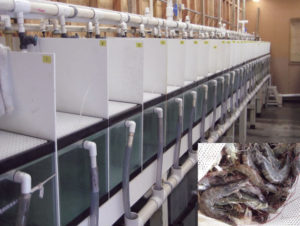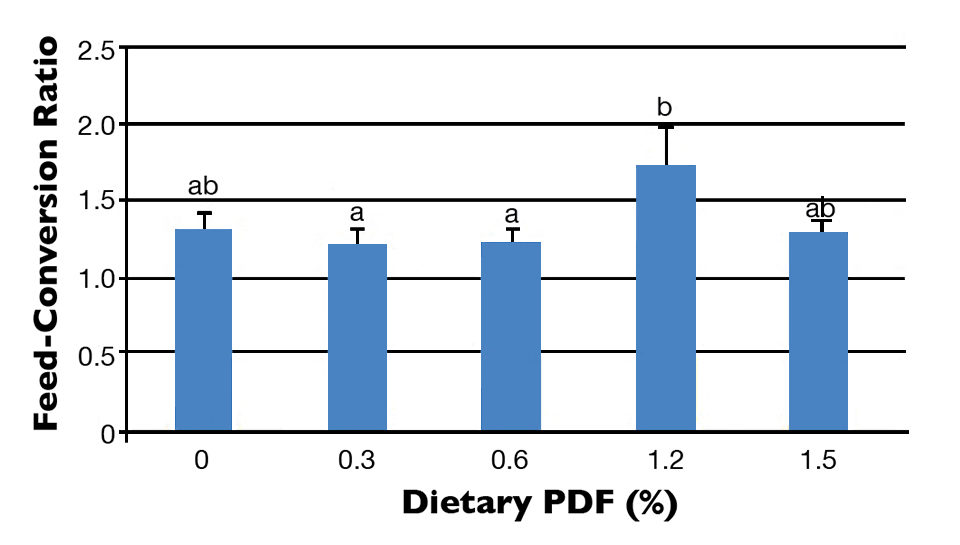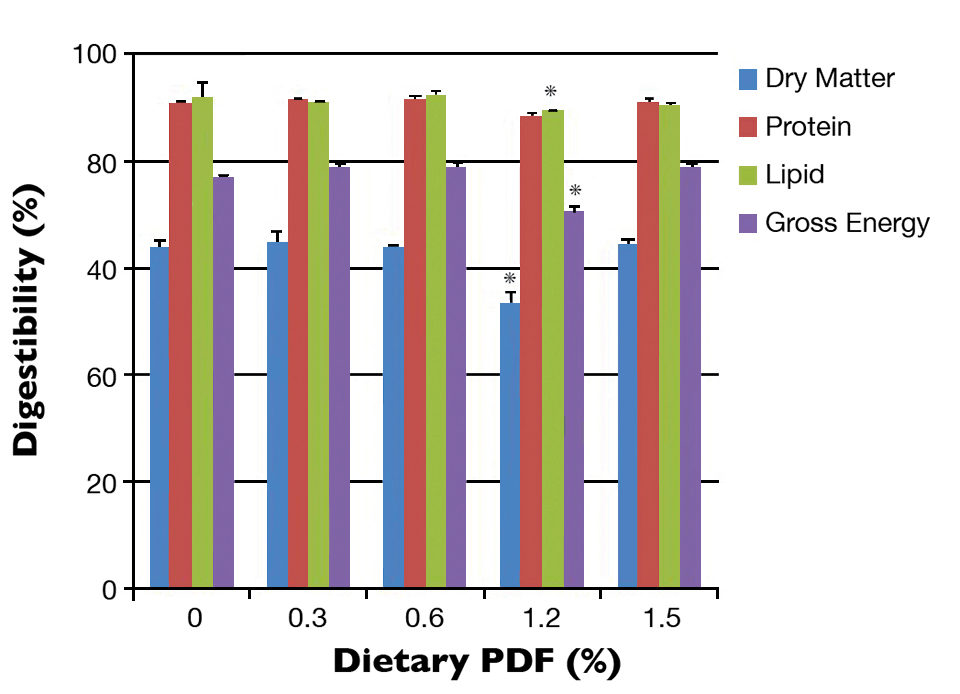Nutrient digestibility reduced

Potassium diformate (PDF) is a conjugated salt that has been used as a non-antibiotic feed additive to promote the growth of livestock. However, very limited studies have been documented in aquatic species, and its effectiveness is contradictory.
A previous study on Atlantic salmon showed that diets containing fishmeal treated with 1.4v PDF improved feed efficiency and growth rate. Results based on the growout of hybrid tilapia also indicated that the addition of 0.2 percent PDF in test diets significantly increased growth and feed efficiency, and decreased bacterial infections.
In contrast, a study of juvenile hybrid tilapia showed that supplementation of PDF at up to 1.2 percent of the diet did not show improvement in growth performance, despite significantly suppressing gut bacteria. Based on the limited available information, the efficacy of PDF in fish performance appears to vary depending on species, life stage, supplementation levels of PDF, test formulation and culture conditions.
Experimental design
The authors recently conducted a growth trial at the Oceanic Institute in Hawaii, USA, to evaluate the effect of PDF on the growth performance and digestibility of Pacific white shrimp cultured in a clearwater system. It was funded by the U.S. Department of Agriculture Agricultural Research Service and through a cooperative agreement with the University of Alaska Fairbanks.
Juvenile Pacific white shrimp (Litopenaeus vannamei) were cultured in an indoor flow-through clean-water system with 31 ppt salinity and 25 degrees-C temperature. They were fed six test diets with 35 percent protein and 6 percent lipid containing PDF at 0, 0.3, 0.6, 1.2 or 1.5 percent.
For each 100 g, the basal diet was formulated to contain 30.0 grams soybean meal, 15.0 grams pollock meal, 6.0 grams squid meal, 2.0 grams menhaden oil, 2.0 grams soy lecithin, 33.8 grams whole wheat, 1.0 gram chromium oxide and 11.2 grams other ingredients (including minerals and vitamins). For each diet, four 52-L tanks were stocked at 12 shrimp/tank. With 0.84-gram initial body weight, the shrimp were hand fed four times daily to apparent satiation for eight weeks.
For the digestibility trial, 120 shrimp with body weights of 9 to 10 grams were cultured in each of 18, 550-L tanks with three tanks/dietary treatment. Chromium oxide was used as an inner marker for measuring apparent digestibility coefficient.

Results
The weekly weight gain of shrimp ranged from 0.6 to 0.8 grams and tended to increase in treatments with 1.2 and 1.5 percent PDF diets, but was not significantly (P > 0.05) different among the dietary treatments. The survival of shrimp was 97 percent or higher in the growth trial.
Feed-conversion ratios (FCRs) were similar for the diets with 0.3 and 0.6 percent PDF, and both were lower than the FCR for the 1.2 percent PDF diet (P < 0.05) However, the FCRs for the control, 1.2 and 1.5 percent PDF diets were similar (P > 0.05).
Shrimp fed the 1.2 percent diet had lower digestibility (P < 0.05) for dry matter, protein and gross energy than the shrimp fed the other diets (Fig. 2). Their digestibility of dietary lipids, however, was not affected (P > 0.05) by the PDF levels.

Perspectives
This study showed that supplementation of PDF at up to 1.5 percent in a diet did not affect the growth and survival of shrimp cultured in a clearwater system. This observation was similar to a previous finding with hybrid juvenile tilapia, but different from the results found in research with Atlantic salmon and growout of hybrid tilapia.
The effects of dietary PDF on FCR and digestibility revealed dose dependence in this study. It is possible the high FCR of the 1.2 percent PDF diet was due to the low digestibility of protein, dry matter and gross energy for the diet. There is very limited information regarding the effects of PDF on nutrient digestibility in aquatic species.
The results of this study were different from those of a previous report that said the addition of PDF to fishmeal during the storage period before feed processing increased protein digestibility. The different efficiencies of dietary PDF found in the current and previous studies may have been due to the different conditions, such as testing species, culture system, dietary formulation or other experimental conditions. The exact reason for this discrepancy was not clear and warrants further investigation.
(Editor’s Note: This article was originally published in the July/August 2011 print edition of the Global Aquaculture Advocate.)
Authors
-
Dong-Fang Deng, Ph.D.
Aquatic Feeds and Nutrition Department
Oceanic Institute
Waimanalo, Hawaii 96795 USA -
Zhi Yong Ju, Ph.D.
Aquatic Feeds and Nutrition Department
Oceanic Institute
Waimanalo, Hawaii 96795 USA -
Warren G. Dominy, Ph.D.
Aquatic Feeds and Nutrition Department
Oceanic Institute
Waimanalo, Hawaii 96795 USA -
Peter J. Bechtel, Ph.D.
U.S. Department of Agriculture, Agricultural Research Service
Subarctic Agricultural Research Unit
Fishery Industrial Technology Center
Kodiak, Alaska, USA -
Scott Smiley, Ph.D.
Fishery Industrial Technology Center
School of Fisheries & Ocean Sciences
University of Alaska
Kodiak, Alaska, USA
Tagged With
Related Posts

Health & Welfare
A case for better shrimp nutrition
Shrimp farm performance can often be below realistic production standards. Use proven nutrition, feeds and feeding techniques to improve profitability.

Health & Welfare
Dietary acidifier potassium diformate improves growth, survival in pangasius
As examined in various studies, potassium diformate can improve the growth and health status of pangasius when the dietary acidifier is included in feed.

Health & Welfare
Dietary potassium diformate improves growth performance of male Nile tilapia
Some of the more promising alternatives to antibiotics for the treatment of Nile tilapia are found in the group of organic acids and their salts.

Health & Welfare
Dietary potassium diformate improves pangasius growth performance, yield
In a laboratory trial, juvenile pangasius given a diet with 0.2 percent potassium diformate (KDF) had better weight gain, feed conversion and survival than fish that did not receive KDF.


